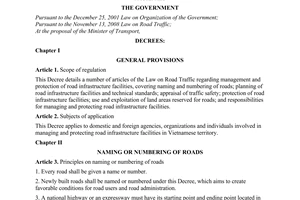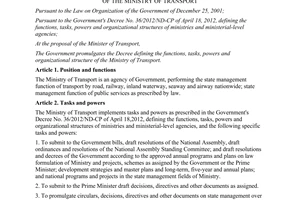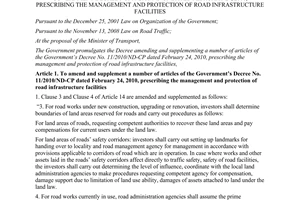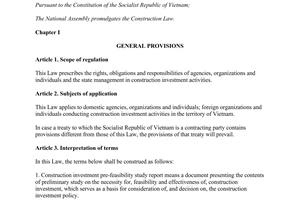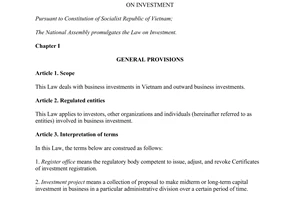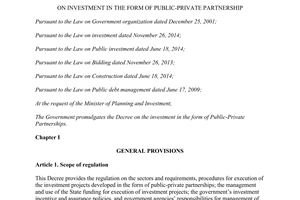Circular 86/2015/TT-BGTVT investment sectors feasibility stuty reports public private partnership investment đã được thay thế bởi Circular 19/2019/TT-BGTVT detailed guidance on investment fields in public private partnership và được áp dụng kể từ ngày 10/07/2019.
Nội dung toàn văn Circular 86/2015/TT-BGTVT investment sectors feasibility stuty reports public private partnership investment
|
MINISTRY OF
TRANSPORT |
SOCIALIST
REPUBLIC OF VIETNAM |
|
No.: 86/2015/TT-BGTVT |
Hanoi, December 31, 2015 |
CIRCULAR
DETAILING GUIDANCE ON INVESTMENT SECTORS AND CONTENTS OF FEASIBILITY STUTY REPORTS OF PUBLIC-PRIVATE PARTNERSHIP INVESTMENT PROJECTS IN TRANSPORTATION SECTOR
Pursuant to the Law on construction No. 50/2014/QH13 dated June 18, 2014;
Pursuant to the Law on investment No. 67/2014/QH13 dated November 26, 2014;
Pursuant to the Government’s Decree No. 15/2015/ND-CP dated February 14, 2015 on investment in the form of public-private partnership;
Pursuant to the Government's Decree No. 107/2012/ND-CP dated December 20, 2012 defining the functions, tasks, powers and organizational structure of the Ministry of Transport;
At the request of the Director General - Head of Public - Private Partnership Investment Project Management Department (PPP Dept.),
The Minister of Transport promulgates this Circular to provide detailed guidance on investment sectors and contents of feasibility study reports of public-private partnership investment projects in transportation sector.
Chapter I
GENERAL PROVISIONS
Article 1. Scope
This Circular provides detailed guidance on investment sectors and contents of feasibility study reports of public-private partnership investment projects in transportation sector.
Article 2. Regulated entities
This Circular is applicable to agencies and entities that are involved in the execution of public-private partnership investment projects (referred to as PPP investment projects) in the transportation sector.
Article 3. General regulations on feasibility study reports
1. The feasibility study report of a PPP investment project shall include principal contents as regulated in Clause 1 Article 25 of the Government’s Decree No. 15/2015/ND-CP dated February 14, 2015 on investment in the form of public-private partnership (referred to as the No. 15/2015/ND-CP) and contents stated in this Circular.
2. The feasibility study report of a construction project shall also include fundamental design whose contents are regulated in Clause 1 Article 54 of the Law on construction No. 50/2014/QH13.
3. Concerned parties may carry out an agreement on other contents on the basis of each project’s specific objectives, nature and conditions provided that such agreed contents must be in conformity with the Decree No.15/2015/ND-CP this Circular and other relevant laws.
4. Other project-related contents and the financial plan of the feasibility study report of the PPP investment project under the Build – Transfer contract shall abide by the Decree No.15/2015/ND-CP and other relevant laws.
Chapter II
INVESTMENT SECTORS
Article 4. Investment in transportation infrastructure works
The projects on the construction and improvement of transportation infrastructure works, including:
1. Road works
a) Road works: roads, bridges, tunnels, ferry terminals;
b) Coach stations, parking lots, roadside stations.
2. Railway works
a) Railway, railway bridges, railway tunnels, railway stations;
b) Railway signalling systems.
3. Inland waterway works: navigable channels; ship locks; inland ports and landing stages.
4. Maritime works: wharfs, warehouses, marine navigable channels.
5. Aeronautical works
a) Airports and airfields;
b) Terminals; depots; parking garages and parking lots.
6. Other projects on the construction and improvement of transportation infrastructure works regulated in Clause 1 Article 4 of the Decree No.15/2015/ND-CP shall abide by decisions granted by the Minister of Transport.
Article 5. Operation of transportation infrastructure
1. The projects on the operation, trading and management of transportation infrastructure works
2. The projects on the supply of equipment and public services in the transportation sector.
Chapter III
CONTENTS OF FEASIBILITY STUDY REPORTS
Article 6. Grounds for preparing feasibility study reports
1. Legal documents are used as the basis for preparing feasibility study reports.
2. Decisions on approving sector and regional development plans, local socioeconomic development plans in connection with projects; decisions and documents granted by competent authorities during the establishment, appraisal and approval for project proposals and other relevant legal documents.
3. Reference documents during the study and establishment of feasibility study reports.
Article 7. Necessity and objectives of investment project
1. The contents of a feasibility study report must include the overview on socio-economic conditions of the country and that of the region where the works or project locates; general assessment of the transportation development relating to the project; effects on the project execution.
2. The feasibility study report must contain the analysis of the necessity of the investment project, social needs and the capacity of the given works in comparison with demands of travel and transporting passengers and goods. To be specific:
a) The feasibility study report must contain the analysis of the capacity of the given works in comparison with demands of travel and transporting passengers and goods before and after the investment project on such works is executed; the potential and benefits accrued from the investment project shall be used as the basis for determining demands, time and scale of the investment project;
b) The forecasting of demands of using the works and the project’s products and services must be performed in a scientific manner, and the forecasting result is obtained on the basis of the division of demands to all means of transportation on the entire network (if any); input figures, grounds and analytical results under various scenarios are detailed (all demand forecasting documents must be enclosed to feasibility study report documents)
c) Existing conditions of the given works and issues need solutions in the project are specified; it also works out related works and projects; the analysis of effects of other projects on the project execution as well as effects of the project execution on surrounding projects and works.
3. Project objectives shall include:
a) General objectives: benefits accrued from the investment project to the national and local socio-economic development; the contribution of the investment project to the general objectives of the transportation sector and those of the country;
b) Specific objectives: quantifiable indicators (quantity, quality and time); the description of solved matters and shortcomings, the number of objects eligible for using the project’s services and other specific objectives are specified.
Article 8. Advantages of the investment in the PPP form
1. Specify the description of the advantages of the investment in the PPP form (including the study on the transformation of investment modes of projects financed by public investment budget), where the advantages of capital sources, payback period, economic efficiency and division of risks between relevant parties are analyzed.
2. Specify restrictions on the investment in the PPP form in comparison with other modes of investment, including: concerned parties’ managerial capability for the project execution; the complexity of the formulation and performance of the project contract.
3. As for the project proposed by the investor, the feasibility study report must include the analysis of the advantages of capital sources, the investor's capacity for the balance of capital; the investor’s managerial capability and experience; the payback period, investment efficiency and capacity for responding to investment risks.
Article 9. The conformity of the investment project to the development plan
1. Specify the description of the conformity of the project to the national, regional and local transportation development plans and the local socioeconomic development plan; the level of fulfillment of the approved planning in case of the phasing of investment or the limitation on technical standards.
2. Specify the description of the suitability of the project for the investment sectors prescribed in Article 4 and Article 5 of this Circular; decision on approval granted by the competent state authority must be enclosed to the feasibility study report if the project does not belong to regulated investment sectors.
3. Specify the description of the conformity of the project with requirements stated in Point c, d, dd Clause 1 Article 15 of the Decree No. 15/2015/ND-CP.
4. If technical standards must be limited or the phasing of investment is required to reduce the complexity or the project or increase the feasibility and attraction of the project, the feasibility study report must contain the analysis of difficulties during the project execution on the basis of the project’s scale and the master plan of executing the project.
Article 10. Scale and location of the project, and use of natural resources
1. Specify scientific bases that are used as the basis for determining the conformity of the investment scale and technical grade of the works with using demand and regulations and standards promulgated by competent authorities; the project’s phasing of investment and limited technical standards (if any).
2. The project location: determine location and area of the project (first point, last point and control points); specify primary place-names passed by the project.
3. Demand on land use: determine the land area (boundary) for arranging the project site; total land area appropriated by the project (temporary or permanent appropriation of land), classification of land according to existing using purposes which shall be used as the basis for determining compensation expenditures and orienting the site clearance.
4. Demand on use of natural resources: collect figures and carry out an assessment on the natural resources at the project area; usable capacity of such natural resources as building materials (reserves and quality) and the feasibility of the exploitation of such natural resources.
Article 11. Natural conditions at the building area and the work current conditions
1. Natural conditions: detail the natural conditions at the construction site and carry out the assessment on effects of the natural conditions on the works/project on the basis of obtained survey figures.
2. Carry out the assessment on the current conditions of the works according to technical criteria of the investment project; specify the status of the given works and its capacity in comparison with operation demands; and usability (entire of a part) of the given works.
3. Carry out the assessment on the current conditions of the works and the valuation of remaining assets of the transportation infrastructure works in conformity with current regulations applicable to projects under Operation – Management contracts (referred to as O&M contracts).
Article 12. Description of technology and primary solutions
1. Provide detailed description of the list of technical regulations and standards applicable to the project and primary technical data.
2. Explain about the conformity of the building location, direction and route of the works, list and scale, type and grade of the works with the investment scale, technical standards and grade of the project; the necessity of the limitation on technical standards (if any); and analyze the technical aspect of the plan of phasing of investment (if any).
3. Provide detailed description of investment contents, primary technical solutions, technological plans and selected equipment in corresponding to each work item (take note on the usability and connection with existing works); solutions for architecture, premises, cross section, facade of the works, main structural dimensions of the construction works; especially, work items or projects with new technological and scientific applications, modern technological lines. When employing new technological applications or materials, the description of their conformity with the national technical regulations and relevant laws must be specified.
4. The feasibility study report must include the calculation of main bearing structures or new structures applied and the consideration of economic – technical aspects in the course of selecting technical plan or design solution for achieving the best one.
5. Describe about relevant infrastructure works; plans for infrastructural connection inside and outside the work; measures against fire and explosion problems; solutions for ensuring traffic safety, environmental hygiene and labour safety.
Article 13. Progress of the project execution and period for performing the project contract
1. Specify the project execution plan (project scheduling) which includes start and end dates of main works of the project such as the formulation of feasibility study report, approval for the investment project, bidding for investor selection, conclusion of the project contract, construction stage, operation stage, transfer stage and other time marks (if any). The project execution plan must be in conformity with actual conditions for ensuring the project progress.
2. As for the construction project: prepare the schedule of construction on the basis of the construction volume and topographic, geological and climate conditions at the project region for determining period of construction stages, calculating expenditures and allocating investment capital.
3. The operating duration of the project starts from the time when the project/work is put into use and operation or the delivery of the project/work is made by the managing agency (if the project is executed under O&M contract) to the end of the period for trading or operating the project as defined in the financial plan; this operating duration shall be calculated in days.
Article 14. Site clearance and resettlement
1. The site clearance and resettlement plan must be in conformity with the demand on land use determined as regulated in Clause 3 Article 10 of this Circular, in accordance with the State regulations on land appropriation, compensation and support for resettlement and other prevailing laws. Such plan consists of:
a) The scale of the site clearance in different cases;
b) The plan of executing the site clearance, compensation and support for resettlement (determine centralized resettlement and dispersed resettlement). In case of centralized resettlement, location and construction scale of the resettlement area, and the support for resettlement (if any) are specified;
c) The financing for the execution of site clearance and resettlement; the payment plan must be in conformity with the execution plan of using as the basis for preparing the capital plan and determining the loan interest;
d) The assessment on effects of the site clearance and resettlement, and solutions. Where necessary, a public consultation may be carried out to set up a suitable plan.
2. The site clearance and resettlement plan must be approved by local competent authorities (people’s committees of provinces or central-affiliated cities or authorized agencies) where the project traverses.
3. The contents of the site clearance and resettlement plan must comply with the Government’s Decree No. 47/2014/ND-CP dated May 15, 2014 on the compensation, support and resettlement and other relevant regulations.
Article 15. Total investment outlay, total investment capital and financial plan
1. Total investment outlay must be determined in a sufficient and accurate manner as regulated by the law on the construction cost management and the Decree No. 15/2015/ND-CP While determining the total investment outlay, the following contents should be considered:
a) Determine the minimum amount of the owner's equity, the loan capital and the state funding for executing the project (if any);
b) Provisions and interest cost incurred during the construction must be determined on the basis of the disbursement schedule which must be in conformity with the project execution schedule (the cash flow must be formed during the project execution);
2. Total investment capital must be determined in a sufficient and accurate manner as regulated in the Decree No. 15/2015/ND-CP and other relevant laws. While determining the total investment capital, the following contents should be considered:
a) Determine the minimum amount of the owner's equity and the loan capital;
b) Grounds and the necessity of the determination of costs relating to the initial working capital for operating the project.
3. The financial plan must include the following fundamental contents:
a) Provide sufficient grounds for determining indicators of the project’s financial model. The assessment on the financial feasibility and the capability of borrowing money is carried out and the payback period and period for gaining profits are determined on the basis of such grounds.
b) Provide detailed description of costs defined in the financial model: total investment capital of the project, enclosed with the project’s financial plan (the capital mobilization plan), estimated interest rate, requirements on loans and other costs;
c) Revenues of the project: specify planned prices and fees in conformity with the project contract, general market price and in compliance with current laws. Additionally, a detailed description and consideration of various scenarios of revenues of the project (basic, minimum and maximum rates) are provided on the basis of the analysis and demand forecasting prescribed in Point b Clause 2 Article 7 of this Circular;
d) Carry out the analysis of the sensibility of input indicators of the financial model (the analysis shall be carried out in both cases where the best financial plan and the worst financial plan are obtained);
dd) Carry out the analysis of output indicators of the financial model for ensuring the capability of borrowing money of the project, including: the debt to equity ratio; the debt service coverage ratio (DSCR); the return on equity or the internal rate of return; the pooled internal rate of return (PIRR); the financial net present value (FNPV) and the payback period (Thv).
4. If the project needs funding from the state budget for increasing the project’s feasibility, a detailed explanation about the project’s contents relating to the state capital shall be specified on the basis of the financial model and the analysis of the financial model of the project. The explanation about the state funding shall include:
a) The necessity of the state capital contribution to the project;
b) Determination of maximum amount, capability of balancing capital; method, plan and disbursement schedule;
c) Requirements on the state capital contribution to the project such as different plans, selected plan, amount, proposed instruments, disbursement and payment procedures;
d) If the PPP investment project is executed under BTL or BLT contract, the amount of the state capital for making payment to the investor providing relevant service and the capability of balancing annual capital are specified.
Article 16. Selection of type of project contract
1. Specify grounds for considering the suitability of the type of the project contract defined in the approved project proposal or selecting another type of the project contract.
2. Carry out the analysis of advantages and disadvantages of the selected type of the project contract which are admitted from the division of risks and elements relating to the project's feasibility.
3. Clarify responsibilities of the competent state agency, the investor and the project enterprise for executing the project (including: design, construction, operation and capital arrangement).
Article 17. Investment capital, capital mobilization plan and feasibility
1. Specify sources of the investment capital and make capital plan for each capital source (including the owner’s equity, loan capital and the state capital) in conformity to the project execution schedule.
2. Evaluate the feasibility of mobilizing capital sources for executing the project; the market demands, payment capacity and the interest of the investor and lenders in the project.
Article 18. Project execution management, operation management and project maintenance
1. Determine the managerial capacity and organizational structure of the competent state agency for each specific stage of the project from the formulation and approval for the feasibility study report.
2. Based on the nature and specific conditions of each project, a set of indicators for assessing the quality of the transportation infrastructure works during its operation (referred to as “KPI”) shall be formulated and used by concerned parties for supervising the project execution. Based on specific characteristics of each project, contents to be supervised during the project execution and requirements on the fulfillment of such contents shall be determined for identifying the KPIs relating to the project; for each indicator, grounds for measurement, provider of information for evaluating such indicator and supervision procedures shall be specified.
3. The management, operation and maintenance of the construction works shall comply with the Government’s Decree No. 46/2015/ND-CP dated May 12, 2015 on the quality control and maintenance of the construction works; the Government’s Decree No. 11/2010/ND-CP dated February 24, 2010 on the management and protection of road infrastructure facilities and the Government’s Decree No. 100/2013/ND-CP dated September 03, 2013 on amendments to certain articles of the Decree No. 11/2010/ND-CP and relevant laws.
Article 19. Analysis of project risks and proposals for investment incentives and guarantee
1. Determine major risks of the project; evaluate effects of risks on the project and propose a best plan of dividing risks between the competent state agency and the investor as well as methods for minimizing the project risks; and clarify responsibilities of concerned parties for managing risks incurred during the project execution. These contents shall be included in the summary of the project risks, including:
a) Determine major risks of the project in a systematic way, including: legal risk, social risk, environmental risk, risk relating to design, construction and production, risk of costs for works construction and completion, financial risk, macroeconomic risk, demand risk, operational risk, risk in finalizing contract and other risks (if any);
b) Describe about major risks of the project; analyze the probability such risks may occur and their effects on the project (effects on costs, schedule, design change, capital distribution, etc,); carry out the assessment on financial effects of such risks on the project; and employ different plans in the financial model to assess such effects in case of need.
c) Assess effects of risks on the project as well as costs and benefits of plans of minimizing risks on the basis of the project’s specific technical, economic and financial conditions and the financial analysis result. The feasibility study report should include the detailed analysis of estimated risks and responsibilities of concerned parties for managing risks incurred during the project execution; proposal for a given support amount from the competent state agency, and regulations on dividing risks between the competent state agency and the investor.
2. Describe about proposals for investment incentives, types of investment guarantee granted by the Government as regulated in Chapter 9 of the Decree No. 15/2015/ND-CP and conditions thereunto appertaining as well as necessary provisions during the performance of the project contract on the basis of the assessment on the project risks and domestic and the current situation on both domestic and international financial markets.
3. Explain about the plan for handling the case where actual revenues accrued from the project deviate significantly from estimated or forecasted revenues for reducing the period of fee collection and capital recovery.
Article 20. Socio-economic efficiency and effects of the project
1. Determine costs and benefits of the project in a general manner (including quantifiable and non-quantifiable benefits). From that basis, the project's socioeconomic efficiency is analyzed, including: the qualitative assessment on the project’s main effects which are non-quantifiable effects or can be quantified but are unable to translate into money term, and the quantification of quantifiable effects in money term; the calculation, quantification and analysis of benefits to users in both cases where the project is executed (including fees paid) and is not executed, the assessment on socio-economic efficiency indicators; the analytical results must include the following indicators:
a) The economic net present value (ENPV);
b) The economic internal rate of return (EIRR);
c) The economic benefit-cost ratio (EBCR).
2. The project's environmental impacts: the feasibility study report contains reports on the assessment on environmental impacts which have been prepared, appraised and approved in accordance with the law on environment.
3. The project's social impacts: The feasibility study report contains the explanation about factors causing social impacts such as the support for resettlement, gender equality, labour issues, etc. during the project execution as regulated by law.
4. Other impacts: The feasibility study report contains the explanation about factors causing impacts on the national defense, the national security and other impacts (if any) during the project execution.
Article 21. Conclusion and recommendations
1. In the conclusion part, a summary of main contents of the feasibility study report of the investment project shall be specified. Such summary must include:
a) Name of the project; name of the competent state agency; name of the project preparation unit or the project-proposing investor;
b) The project location and used land area (if any);
c) Scale of the project and primary technical standards;
d) Total investment capital or total investment outlay (determine the source of the state capital, if any).
dd) Type of the project contract and its period (estimated progress of the project and operating duration);
e) Financial indicators of the project (input and output indicators);
g) Other contents.
2. In the suggesting part, recommendations and proposals are specified (if any).
Article 22. Other contents
Apart from the contents stated above, the feasibility study report must contain other contents as regulated by the law and relevant technical regulations and standards.
Chapter IV
IMPLEMENTATION
Article 23. Effect
This circular takes effect as of February 15, 2016.
Article 24. Implementation organization
1. The Chief of the
Ministry Office, Chief Inspector of the Ministry, Director General of Directorate
for Roads of Vietnam, General Directors of Departments and Project Management
Boards affiliated to the Ministry of Transport, Heads of agencies and
individuals concerned shall implement this Circular.
2. Heads of agencies shall organize the implementation of this Circular and suggest types of PPP projects in conformity with their operation.
3. Difficulties that arise during the implementation of this Circular should be reported to the Ministry of Transport for guidance./.
|
|
MINISTER |
------------------------------------------------------------------------------------------------------
This translation is made by LawSoft and
for reference purposes only. Its copyright is owned by LawSoft
and protected under Clause 2, Article 14 of the Law on Intellectual Property.Your comments are always welcomed
